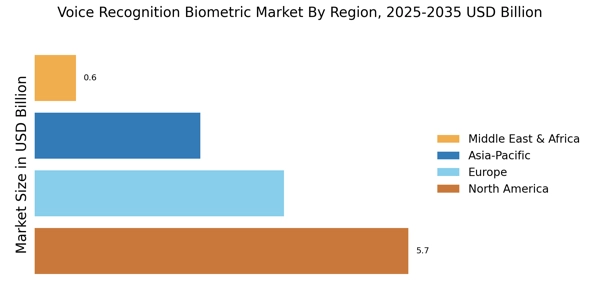Increasing Regulatory Compliance Requirements
The Voice Recognition Biometric Market is influenced by the rising regulatory compliance requirements across various sectors. Governments and regulatory bodies are implementing stringent guidelines to protect consumer data and ensure secure transactions. This has led organizations to adopt voice recognition technology as a means to comply with these regulations. For instance, financial institutions are required to implement robust identity verification processes, and voice biometrics provide a reliable solution. The market is expected to grow as companies seek to meet compliance standards while enhancing security measures. Analysts predict that the demand for compliant biometric solutions will drive the Voice Recognition Biometric Market, as organizations prioritize adherence to regulations while safeguarding customer information.
Growing Demand for Enhanced Security Solutions
The Voice Recognition Biometric Market is experiencing a surge in demand for enhanced security solutions across various sectors. Organizations are increasingly adopting voice recognition technology to safeguard sensitive information and prevent unauthorized access. According to recent data, the market for biometric security solutions is projected to reach USD 40 billion by 2026, with voice recognition playing a pivotal role. This trend is particularly evident in financial institutions and government agencies, where the need for robust security measures is paramount. The ability of voice recognition systems to provide a unique biometric identifier enhances security protocols, making them more reliable than traditional methods. As cyber threats evolve, the Voice Recognition Biometric Market is likely to expand, driven by the necessity for advanced security measures.
Rising Consumer Preference for Contactless Solutions
In the Voice Recognition Biometric Market, there is a notable shift towards contactless solutions, particularly in the wake of increasing health and safety concerns. Consumers are gravitating towards technologies that minimize physical contact, and voice recognition systems offer a seamless, touch-free alternative for authentication. This trend is reflected in the growing implementation of voice-activated systems in various applications, including smart home devices and mobile banking. Market analysts suggest that the demand for contactless biometric solutions could lead to a compound annual growth rate of over 20% in the coming years. As more consumers prioritize convenience and safety, the Voice Recognition Biometric Market is poised for significant growth, aligning with broader trends in consumer behavior.
Integration with Artificial Intelligence Technologies
The Voice Recognition Biometric Market is increasingly integrating with artificial intelligence (AI) technologies, enhancing the accuracy and efficiency of voice recognition systems. AI algorithms enable these systems to learn from user interactions, improving their ability to recognize and authenticate voices in diverse environments. This integration is expected to drive market growth, with projections indicating that the AI in the voice recognition market could reach USD 15 billion by 2025. The synergy between AI and voice recognition not only enhances user experience but also expands the potential applications of biometric systems in sectors such as healthcare, finance, and customer service. As AI continues to evolve, the Voice Recognition Biometric Market is likely to benefit from innovations that further refine voice recognition capabilities.
Expansion of Voice-Activated Services in Various Industries
The Voice Recognition Biometric Market is witnessing an expansion of voice-activated services across multiple industries, including retail, healthcare, and automotive. This trend is driven by the increasing consumer preference for hands-free interactions and the convenience offered by voice technology. For example, in the retail sector, businesses are implementing voice recognition systems to streamline customer service and enhance user experience. The healthcare industry is also adopting voice biometrics for patient identification and record access, improving efficiency and security. Market forecasts indicate that the voice-activated services segment could grow significantly, contributing to the overall expansion of the Voice Recognition Biometric Market. As industries continue to embrace voice technology, the market is likely to see sustained growth and innovation.


















Leave a Comment